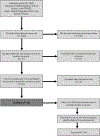Diet, adiposity, and the gut microbiota from infancy to adolescence: A systematic review
- PMID: 33590719
- PMCID: PMC10762698
- DOI: 10.1111/obr.13175
Diet, adiposity, and the gut microbiota from infancy to adolescence: A systematic review
Abstract
Early life gut microbiota are affected by several factors that make identification of microbial-adiposity relationships challenging. This review evaluates studies that have investigated the gut microbiota composition associated with adiposity in infants, children, and adolescents and provides evidence-based nutrition recommendations that address microbiota-adiposity links. Electronic databases were systematically searched through January 2020. Eligible studies were published in English and analyzed gut microbiota and adiposity among individuals aged birth to 18 years. Abstracts and full-text articles were reviewed by three independent reviewers. Of 45 full-text articles reviewed, 33 were included. No difference in abundance was found for Bacteroidetes (n = 7/15 articles), Firmicutes (n = 10/17), Actinobacteria (n = 8/12), Proteobacteria (n = 8/12), Tenericutes (n = 4/5), and Verrucomicrobia (n = 4/6) with adiposity. Lower abundance of Christensenellaceae (n = 3/5) and Rikenellaceae (n = 6/8) but higher abundance of F. prausnitzii (n = 3/5) and Prevotella (n = 5/7) were associated with adiposity. A lack of consensus exists for gut microbial composition associations with adiposity. A healthy gut microbiota is associated with a diet rich in fruits and vegetables with moderate consumption of animal fat and protein. Future research should use more robust sequencing technologies to identify all bacterial taxa associated with adiposity and evaluate how diet effects these adiposity-associated microbes.
Keywords: adiposity; adolescence; childhood; gut microbiota.
© 2021 World Obesity Federation.
Conflict of interest statement
Figures


Similar articles
-
Home treatment for mental health problems: a systematic review.Health Technol Assess. 2001;5(15):1-139. doi: 10.3310/hta5150. Health Technol Assess. 2001. PMID: 11532236
-
Comparison of the effectiveness of inhaler devices in asthma and chronic obstructive airways disease: a systematic review of the literature.Health Technol Assess. 2001;5(26):1-149. doi: 10.3310/hta5260. Health Technol Assess. 2001. PMID: 11701099
-
Gut Microbiota Composition in Prediabetes and Newly Diagnosed Type 2 Diabetes: A Systematic Review of Observational Studies.Front Cell Infect Microbiol. 2022 Aug 15;12:943427. doi: 10.3389/fcimb.2022.943427. eCollection 2022. Front Cell Infect Microbiol. 2022. PMID: 36046745 Free PMC article.
-
Different corticosteroids and regimens for accelerating fetal lung maturation for babies at risk of preterm birth.Cochrane Database Syst Rev. 2022 Aug 9;8(8):CD006764. doi: 10.1002/14651858.CD006764.pub4. Cochrane Database Syst Rev. 2022. PMID: 35943347 Free PMC article.
-
Synbiotics, prebiotics and probiotics for solid organ transplant recipients.Cochrane Database Syst Rev. 2022 Sep 20;9(9):CD014804. doi: 10.1002/14651858.CD014804.pub2. Cochrane Database Syst Rev. 2022. PMID: 36126902 Free PMC article.
Cited by
-
Functional Comparison of Clostridium butyricum and Sodium Butyrate Supplementation on Growth, Intestinal Health, and the Anti-inflammatory Response of Broilers.Front Microbiol. 2022 Jun 2;13:914212. doi: 10.3389/fmicb.2022.914212. eCollection 2022. Front Microbiol. 2022. PMID: 35722291 Free PMC article.
-
Biofilm Composition Changes During Orthodontic Clear Aligners Compared to Multibracket Appliances: A Systematic Review.Microorganisms. 2025 Apr 30;13(5):1039. doi: 10.3390/microorganisms13051039. Microorganisms. 2025. PMID: 40431212 Free PMC article. Review.
-
Early development and dynamics of nasopharyngeal microbiota in infants during the COVID-19 pandemic: a 2-year prospective birth cohort study.Respir Res. 2025 Jul 10;26(1):240. doi: 10.1186/s12931-025-03307-5. Respir Res. 2025. PMID: 40640745 Free PMC article.
-
Bisphenol A exposure affects specific gut taxa and drives microbiota dynamics in childhood obesity.mSystems. 2024 Mar 19;9(3):e0095723. doi: 10.1128/msystems.00957-23. Epub 2024 Mar 1. mSystems. 2024. PMID: 38426791 Free PMC article.
-
Influence of perinatal and childhood exposure to tobacco and mercury in children's gut microbiota.Front Microbiol. 2024 Jan 5;14:1258988. doi: 10.3389/fmicb.2023.1258988. eCollection 2023. Front Microbiol. 2024. PMID: 38249448 Free PMC article.
References
Publication types
MeSH terms
Grants and funding
LinkOut - more resources
Full Text Sources
Other Literature Sources

